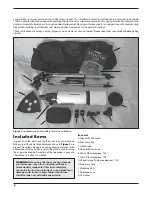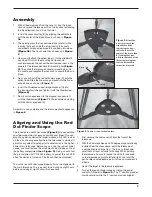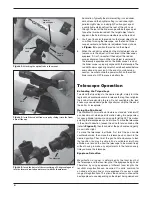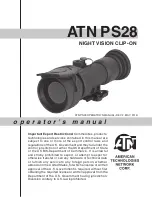
viewing conditions. Your StarBlast 102mm refractor comes with
25mm (E) and 10mm (F) Plossl eyepieces, which will suffice
nicely to begin with. You can purchase additional eyepieces later
if you wish to have more magnification options.
Magnification is calculated as follows:
Telescope Focal Length (mm)
= Magnification
Eyepiece Focal Length (mm)
For example, the StarBlast 102mm has a focal length of 600mm,
which when used with the supplied 25mm eyepiece yields:
600mm
= 24x
25mm
The magnification provided by the 10mm eyepiece is:
600mm
= 60x
10mm
The maximum attainable magnification for a telescope is directly
related to how much light it can gather. The larger the aperture,
the more magnification is possible. In general, a figure of 50x
per inch of aperture is the maximum attainable for most tele-
scopes. Going beyond that will yield simply blurry, unsatisfac-
tory views. Your StarBlast 102mm refractor has an aperture
of 102mm, or 4 inches, so the maximum practical magnifica-
tion would be about 200x (4 x 50). This level of magnification
assumes you have ideal atmospheric conditions for observing
(which is seldom the case).
Keep in mind that as you increase magnification, the brightness
of the object viewed will decrease; this is an inherent principle
of the laws of physics and cannot be avoided. If magnification is
doubled, an image appears four times dimmer. If magnification
is tripled, image brightness is reduced by a factor of nine!
So start with low power by using the 25mm eyepiece, then try
switching to the 10mm eyepiece later if you want to boost the
magnification.
Focusing the Telescope
To focus the telescope, turn the focus wheels
(Figure 8)
for-
ward or back until you see your target object in the eyepiece.
Then make finer adjustments until the image is sharp. If you’re
having trouble achieving initial focus, rack the focuser drawtube
all the way in using the focus wheels, then while looking into
the eyepiece slowly turn the focus wheels so that the drawtube
extends outward. Keep going until you see your target object
come into focus. Note that when you change eyepieces you
may have to adjust the focus a bit to get a sharp image with the
newly inserted eyepiece.
Terrestrial and Celestial
Viewing with the StarBlast
102mm
The Orion StarBlast 102mm is equipped with a 90-degree “cor-
rect-image” diagonal (G), which provides an upright, “normal”
view. Because of this, the StarBlast is an excellent terrestrial
telescope for viewing Earth-based scenes during daylight hours.
More powerful than binoculars, it can get you visually “up close”
to your target for vivid, detailed views. For best results, howev-
er, DO NOT VIEW OUT WINDOWS. The glass in a window is
approximately 1000 times less accurate than the optics of your
StarBlast 102mm – so it will soften your views, and things will
seem to be slightly out of focus. If you must view through a win-
dow, use the lowest power available (and open the window!).
Figure 7.
Insert the 25mm eyepiece into the 90-degree diagonal and
secure it with the thumbscrew.
Figure 8.
The telescope is now mounted and ready for action!
Thumbscrew
Eyepiece
Focus
wheels
Pan handle
Twist
Azimuth
tension
knob
5













